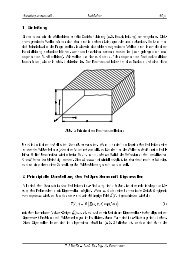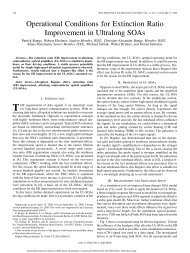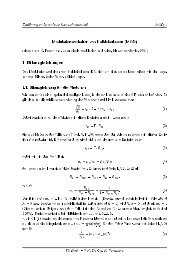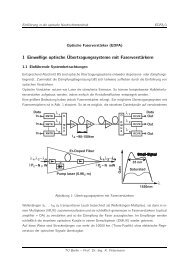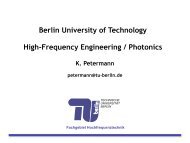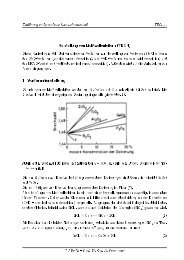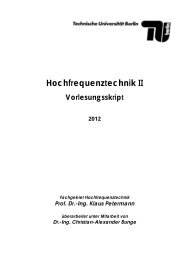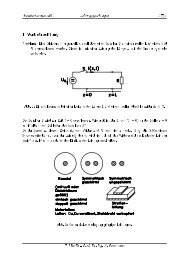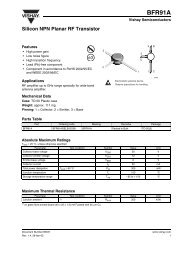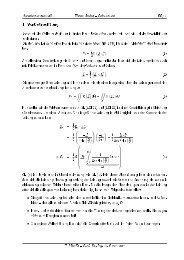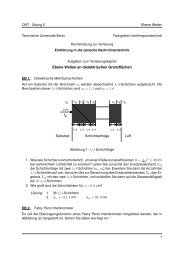All-Optical Wavelength Conversion With Extinction Ratio ...
All-Optical Wavelength Conversion With Extinction Ratio ...
All-Optical Wavelength Conversion With Extinction Ratio ...
You also want an ePaper? Increase the reach of your titles
YUMPU automatically turns print PDFs into web optimized ePapers that Google loves.
938 IEEE JOURNAL OF QUANTUM ELECTRONICS, VOL. 46, NO. 6, JUNE 2010<br />
Fig. 2. Conceptual setup of the wavelength converter including the ER improvement;<br />
is either , +1 or 0 1 depending which<br />
kind of wavelength conversion mechanism shall be used.<br />
III. SIMULATION SETUP<br />
Fig. 1. Probe signal’s amplification asymmetry due to the dynamical part of the<br />
gain suppressions in the UL-SOA’s saturated section (1 = 0 ;<br />
jE j P ).<br />
Unlike in SOAs, the main part of UL-SOAs is saturated by<br />
the amplified signals and the amplified spontaneous emission<br />
(ASE) noise after a certain length. For this reason, UL-SOAs<br />
can be regarded as being divided into an amplifying section<br />
and a saturated section. For bulk SOAs with typical dimensions,<br />
the transition between these sections takes place after approximately<br />
1 mm of propagation. The amplifying section has the<br />
same properties as a short SOA and the saturated section can be<br />
regarded as another device with different properties. Because of<br />
the high optical power after the amplifying section, the carrier<br />
density in the saturated section is fixed to the net transparency<br />
level. If the signal levels change much faster than the carrier lifetime,<br />
the carrier density in the amplifying section is only dependent<br />
on the average optical power. If the signal remains at one<br />
of the states longer than the carrier lifetime, the length and the<br />
gain of the amplifying section changes. As a result bit pattern effects<br />
occur. For high data rates with fast changing signal states,<br />
the performance is not limited by the slow interband effects.<br />
Only the fast nonlinear intraband effects influence the signals in<br />
the saturated section. Their response time is about 1000 times<br />
shorter compared to the slow interband effects, but their impact<br />
is also weaker. For this reason, the desired operation point for<br />
signal processing is when the carrier density inside the UL-SOA<br />
is shifted as far as possible towards the front of the device in<br />
order to efficiently use the length of the device and to avoid the<br />
influence of back-propagating ASE.<br />
Moreover, the UL-SOA shows a Bogatov-like effect over several<br />
nm due to the increased efficiency of the fast intraband effects.<br />
In [15] Bogatov has demonstrated that the beating of two<br />
input signals creates dynamic gain and index gratings in nonlinear<br />
semiconductor media. Because of the interaction of these<br />
dynamic gratings, the weaker signal’s amplification is dependent<br />
on the stronger signal’s wavelength detuning. Due to the<br />
-factor causing the index pulsation, the probe signal is stronger<br />
amplified on the longer wavelength side of the pump signal<br />
(Fig. 1). In [15] the pulsations are due to the slow interband<br />
effects, while in [14], [16] a similar effect based on the fast intraband<br />
effects was presented. Due to the fast intraband effects,<br />
this Bogatov-like effect is suitable for high-speed operations.<br />
The conceptual setup of the AOWC with ER improvement<br />
is shown in Fig. 2. Due to the two input signals, a parametric<br />
amplification of the data signal in dependence of the CW signal<br />
can be obtained, resulting in a nonlinear transfer characteristic<br />
over<br />
. <strong>With</strong> the help of the nonlinear<br />
gain characteristic, the ER can be improved. To achieve<br />
a maximum ER improvement the UL-SOA’s operating point is<br />
set at a steep slope of the nonlinear transfer characteristic.<br />
The investigated device is a 4 mm-long bulk SOA. The geometrical<br />
structure has been optimised in order to increase the<br />
efficiency of the nonlinear effects (decreased coupling losses<br />
and increased mode confinement [20]). The values are given in<br />
Table I. The driving current is 300 mA/mm.<br />
In later applications the presented scheme might be used<br />
at a switching node in long-haul transmission systems. After<br />
being transmitted over several spans, a degenerated channel<br />
approaches the node. First the whole channel will be optically<br />
amplified with an EDFA before the WDM channel of interest<br />
will be converted to the new wavelength. For this reason, we<br />
assume the following parameters for the input data signal after<br />
an EDFA: , . The power for<br />
the additionally injected CW is:<br />
. The signals’<br />
wavelength are 1560 nm and 1564 nm, respectively. The<br />
wavelength alignment depends on which kind of wavelength<br />
conversion mechanism shall be used. The data signals being<br />
investigated are 100 Gb/s OOK-RZ-50% modulated PRBSs<br />
of orders up to 25. The bandpass filter after the UL-SOA<br />
is a second-order Gaussian filter with a 3 dB-bandwidth of<br />
275 GHz.<br />
Due to limited computation capacity it was not possible to<br />
simulate complete PRBSs longer than . For this reason,<br />
critical bit sequences were taken to estimate the impact of pattern<br />
effects on the regeneration scheme. As already mentioned<br />
in Section II, pattern effects occur if the data signal remains long<br />
at one of the states. Therefore, the critical bit sequences contain<br />
various combinations of the following bit sequences: constant<br />
signal states, one inverted bit within a constant signal state and<br />
alternating bit sequences. These combinations of bit sequences<br />
are expected to create worst-case bit pattern effects. A detailed<br />
description of the critical bit sequence is given in the Appendix .<br />
The simulations have been done with the same model as in<br />
[21], [22] where a very good match between measurements and<br />
simulation results has been demonstrated.<br />
Authorized licensed use limited to: Technische Universitaet Berlin. Downloaded on March 29,2010 at 05:14:58 EDT from IEEE Xplore. Restrictions apply.



